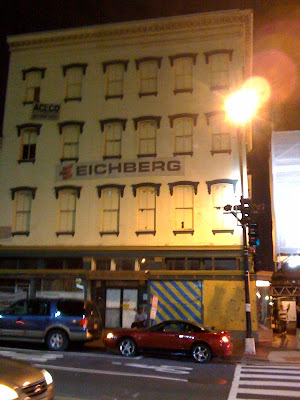
Coming off its recent zoning approval, the
Art Place and Shops at Fort Totten development is now being readied for the initial stages of planning and demolition, in what will be a 2 million s.f. transit-oriented project with a mixture of community-serving retail, residential and arts and cultural space to the area between South Dakota Avenue and the Fort
Totten Metro. The
Morris and Gwendolyn Cafritz Foundation are seeking bids to work on the nearly 17 acres of land in northeast
DC's Fort
Totten community. The project will be executed in several stages with one massive building in the first phase and the rest to follow. Developers expect to begin construction in the first half of 2010 and have the first building ready

within 24 to 36 months from now.
Initial schematic designs call for the demolition of the Riggs Family Apartments and three warehouses currently on the site. The demolition will make room for the construction of four buildings comprised of 929 multi-family one- to three-bedroom units; 305,000 square feet of retail space; 170,000 square feet of cultural and arts spaces; and a 47,000-square-foot children's museum. Ehrenkrantz Eckstut and Kuhn
(EE&K) is the master planner for the site,
Shalom Baranes Architects (SBA) has designed the first of the four buildings, and
MV+A Architects is designing the retail, all to meet basic
LEED certification standards.

The first phase of construction will begin with Building A at South Dakota and Galloway Street
, which will be joined below grade by a common foundation and parking garage, but above grade will appear as 3 distinct, adjoining buildings. The residential portion of this phase will offer 529 units including 98 units of senior housing and 43 affordable units out of a project total of 161 units set aside as affordable at 60 to 80% AMI. The retail space includes approximately 59,000 s.f. for a grocery store with supporting retail lining the street as residents walk to the metro.
Cafritz Foundation Board Member
Jane Cafritz speculated this retail could include stores like card shops, dry cleaners and restaurants, and is shopping around for a grocery store to anchor the first stage of development.
Though buildings B, C and D received approval,
Cafritz said their exact designs are still up in the air and dependent on market conditions around the time of construction. In the PUD zoning approval, Building B is planned for three stories of retail and cultural use to include the 47,000-s.f. ground floor children's museum, ground and second floor retail and space for a child care facility and seniors' center.

The planned seven-story "cultural and arts spaces" in Building D would potentially serve both the Washington National Opera and the Shakespeare Theatre for storage, rehearsal space and related shops. The developers also offer to provide upwards of 20,000 s.f. in this building for a public library and an additional 30,000 s.f. of "community space;" giving away space like free samples at Costco.
The eight-story Building C is planned as entirely residential, built in two C-shaped wings, joined at the second level, to accommodate the possibility of a new 3rd Street connecting the Arts Place property to the neighboring Food and Friends property, should the neighbors decide to sell or redevelop at a later date. Of the 400 rental units, 30 may be set aside as affordable for artists-
everyone loves the
arts these days.

All this development does not come without growing pains. Several current community members living in the Riggs Family Apartments were outspoken during the PUD review process. They will be displaced from their current home and moved into temporary housing on the same site until the new affordable spaces in the Arts Place project are ready. One senior from the community and a resident of the
Cafritz apartments testified in objection to the handling of the current residents, saying that residents had not been told where they were going or when.
Despite community complaints, Jane
Cafritz tried to paint a rosier picture, adding that that temporary homes for the tenants are fully refurbished with new appliances and the developers will try to accommodate seniors with first floor units. Highlighting the benefits of the new project though,
Cafritz said the foundation will pay the gap between the rates on the affordable units and the actual cost of a market rate units, absorbing that cost for "20 years or the life of the tenant," whichever comes first. The former Riggs tenants will have first dibs on the new affordable residences at Arts Place and Shops.
Building A images courtesy of Interface Multimedia.
Washington DC Real Estate News.



 change to any developer, but tack on rules that make some lenders jittery.
Back in the days when no-doc loans were
change to any developer, but tack on rules that make some lenders jittery.
Back in the days when no-doc loans were 







 are public and 208 are private."
are public and 208 are private."  Whether or not construction will ever begin on the four story, 46-unit second phase of development remains to be seen. No date for Phase 2's construction has been set. That said, RST Development is pushing forward into the subcontracting stage of Phase 1 despite the setbacks in the market so far.
Whether or not construction will ever begin on the four story, 46-unit second phase of development remains to be seen. No date for Phase 2's construction has been set. That said, RST Development is pushing forward into the subcontracting stage of Phase 1 despite the setbacks in the market so far. 









































